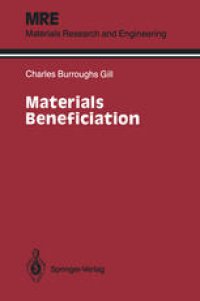
Ebook: Materials Beneficiation
Author: Charles Burroughs Gill (auth.)
- Tags: Characterization and Evaluation of Materials, Condensed Matter Physics
- Series: Materials Research and Engineering
- Year: 1991
- Publisher: Springer-Verlag New York
- Edition: 1
- Language: English
- pdf
The purpose of this book is to provide a broad, comprehensive, up-to-date coverage of current beneficiation techniques and processes that are used for both metallic and nonmetallic minerals; and for other materials, such as household and industrial solid wastes, that are also processed by conventional beneficiation methods in their standard methods of recycling and reclamation. Conservation of natural resources is an adjunct of beneficiation in that we have used up once-available deposits of high-grade ores, leaving only the low-grade deposits that must be beneficiated to upgrade them to sufficiently high levels for processing and metal recovery by current extractive technology. Conservation is also important in the reclamation and recycling of indestructible, noncorrosive materials, so that they may be recovered and reused many times over. The mainly physical, relatively uncomplicated, beneficiation treatments also save large quantities of energy, as these comparatively simple operations are all relatively low energy consumers, when compared with the later separation operations of pyro and electrical nature, which are very high energy consumers. Environmentally, both air and water pollution from beneficiation treatments are either quite low or can easily be controlled, and are gas-free and operated at ambient temperature, to make them one of the cleaner and lower polluting processes used in material treatments.
The book is on the current treatment and processes having to do with materials beneficiation. It also goes into a comprehensive coverage of common recycling methods and procedures, which none of the other books touch on. This new, additional material is becoming more and more a general practice worldwide. The book is intended for an audience that would include junior and senior-level college students studying metallurgy, materials, mining, civil and environmental engineering, and for engineers in these fields dealing with beneficiation processes, and for municipal and environmental officials concerned with recycling.
The book is on the current treatment and processes having to do with materials beneficiation. It also goes into a comprehensive coverage of common recycling methods and procedures, which none of the other books touch on. This new, additional material is becoming more and more a general practice worldwide. The book is intended for an audience that would include junior and senior-level college students studying metallurgy, materials, mining, civil and environmental engineering, and for engineers in these fields dealing with beneficiation processes, and for municipal and environmental officials concerned with recycling.
Content:
Front Matter....Pages i-x
Introduction....Pages 1-9
Crushing....Pages 10-42
Screens and Sizing....Pages 43-47
Fine Grinding....Pages 48-81
Classification....Pages 82-104
Dewatering....Pages 105-127
Magnetic Separation....Pages 128-140
Electrostatic Separation....Pages 141-147
Gravity Concentration....Pages 148-175
Flotation....Pages 176-215
Recycling....Pages 216-237
Back Matter....Pages 239-245
The book is on the current treatment and processes having to do with materials beneficiation. It also goes into a comprehensive coverage of common recycling methods and procedures, which none of the other books touch on. This new, additional material is becoming more and more a general practice worldwide. The book is intended for an audience that would include junior and senior-level college students studying metallurgy, materials, mining, civil and environmental engineering, and for engineers in these fields dealing with beneficiation processes, and for municipal and environmental officials concerned with recycling.
Content:
Front Matter....Pages i-x
Introduction....Pages 1-9
Crushing....Pages 10-42
Screens and Sizing....Pages 43-47
Fine Grinding....Pages 48-81
Classification....Pages 82-104
Dewatering....Pages 105-127
Magnetic Separation....Pages 128-140
Electrostatic Separation....Pages 141-147
Gravity Concentration....Pages 148-175
Flotation....Pages 176-215
Recycling....Pages 216-237
Back Matter....Pages 239-245
....